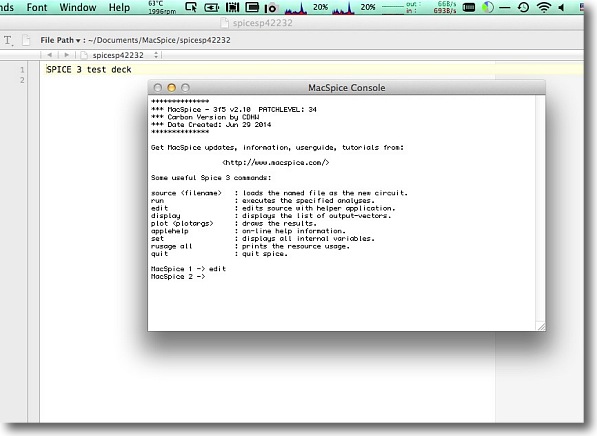

VALUE is the resistance (in ohms) and may be positive or negative but not zero. The most common ones are as follows: Resistors General form: Section 3 lists all the available circuit elements.
MACSPICE TUTORIAL MANUAL
Section 2.1 of the Users' Manual contains more details about the structure and syntax of the SPICE-3 source file. Lines) and MOSFET substrate nodes (which have two internal connections Every node must have at least two connectionsĮxcept for transmission line nodes (to permit unterminated transmission Each node in the circuit must have aĭc path to ground. Sources and/or inductors and cannot contain a cut-set of current The circuit cannot contain a loop of voltage Node names can be arbitrary character strings. 'M' and 'm' mean 'milli-' use 'MEG' to represent 'mega-'. Note that 1000, 1000.0, 1000Hz, 1e3, 1.0e3, 1KHz, and 1Kĭon't forget: Spice is not case-sensitive, so both scale-factors Number, and M, MA, MSec, and MMhos all represent the same scaleįactor.

Hence, 10, 10V, 10Volts, and 10Hz all represent the same Letters immediately following a number that are not scale factorsĪre ignored, and letters immediately following a scale factor are Aįloating-point number can be followed by an integer exponent or one of Number fields may be integers or floating-point numbers. One canĪvoid a lot of confusion by typing source files in lower-case Processor is usually case sensitive and it does not consider, forĮxample, r1 and R1 to be synonyms. Names during analysis, others are case-insensitive. Note: Some versions of SPICE use case sensitive element and node Name field must begin with a letter (A through Z). ('=') sign, or a left or right parenthesis extra spaces are ignored. Rout, and r3ac2zy are valid resistor names.įields on a line are separated by one or more blanks, a comma, an equal Must begin with the letter 'r' and can contain one or more characters. The first letter of theĮlement name specifies the element type. That gives the element name, the circuit nodes to which the element isĬonnected, and the values of the parameters that determine theĮlectrical characteristics of the element.

Circuit ElementsĮach element in the circuit is specified in the source file by a line Has a 'show invisibles' option which displays such characters. On School of Physics machines the default editor SPICE does not like 'invisible' or 'junk' characters in its source file they often To perform on the circuit and how results are to be displayed

SPICE orignally consisted of two parts: the SPICE calculation engine Further information about specific features can be foundīy following the hyperlinks to the complete SPICE-3 SimSheets and gives only brief descriptions of the most commonly This document gives the basic information required to analyse a SPICE is a useful tool, not a magic wand, and its results shouldĪlways be examined critically in some cases it may not give results atĪll, for others the results may be misleading. Of many commercial simulators, and academic projects.
MACSPICE TUTORIAL CODE
The source code was made freely available and has been used as the basis Research Laboratory of the University of California, Berkeley (1975). It was originally developed at the Electronics
MACSPICE TUTORIAL SIMULATOR
Williams IntroductionĪn analog-circuit simulator that is used to calculate and display theĬircuit behaviour. Quickstart Tutorial for Spice 3 by Charles D.H.


 0 kommentar(er)
0 kommentar(er)
